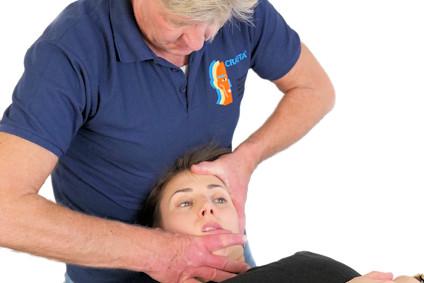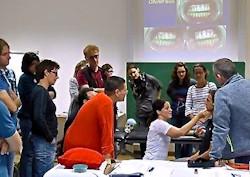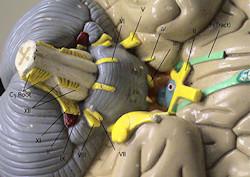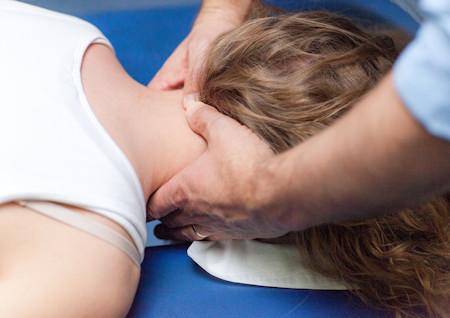
The aim of the certification is to assess, if the capabilities of the craniofacial region are understood, not only the assessment and treatment skills, but also the self-reliant ability to construct a treatment plan concerning the pathologies and dysfunction, which were discussed during the courses. The most important aim is to understand the common theme of the concept.
Therefore, here are some important tips, which will be useful in preparing for the exam:
Concentrate on general theory guidelines, which are also important for the practice. Do not learn the theory in detail.
During the oral practical portion of the exam you will asked theoretical questions and asked to demonstrate some practical skills.
In the appendix you will find an overview of the most important items, subdivided into courses, about what might be asked on the exam. Furthermore, the examination rules are included. Please read thoroughly. We apologize for any inconvenience, however, complaints after the exam are not accepted if they are addressed in the examination rules.
Certification team:
Christian Voith
Prof. Dr. Harry von Piekartz
Topic area 1 - Temporomandibular region
- Palpation bones, ligaments/capsule, muscles (muscles of mastication, supra- and infrahyoid muscles, short neck muscles)
- Classification in sagittal plane by Angle
- Inspection:
- Eye, zygoma, mouth line, Vertical dimension by Trott
- UPPM (Upright Postural Position of the Mandible)
- Extra-oral:
- Tonus of muscles of mastication; digastric m.; sternocleidomastoid m.; trapezius m.
- Centric position of the head of the mandible
- Palpation from inside and outside the ear
- Palpation of lymphatic nodes
- Intra-oral:
- Occlusion; Overjet; Freeway space; Overbite; midline; maximal intercuspation; axial exposure; contact: light and short; Protrusion/Retrusion; Laterotrusion, Habitual occlusion; centric occlusion; Abrasia; Gingiva; tongue impressions; cheek impressions
- Movement behavior during opening and closing and interpretation
- Correction - overcorrection of the mandible and interpretation
- Functional differentiation tests on the basis of sensoric answer (principles)
- Rotation differentiation temporomandibular- craniocervical
- Occlusal kinesthetic sensitizing test (OKST) (I), Occlusion vs craniocervical
- Active tests with overpressure: Depression; Protrusion; Retrusion; Laterotrusion
- Static Tests
- Passive Tests/Accessory movements: longitudinal movements caudal/cranial (bilateral, unilateral), transverse movements to lateral, transverse movements to medial, anterior- posterior movements (a/p) (unilateral, bilateral), posterior- anterior movement (p/a), (unilateral, bilateral)
- Variations; in angulation
- Myocentric condyle test
- Neuromuscular habit reversal technique; TTBS-awareness exercise
- General homework: Hinge movement, snake exercise; static coordination and interpretation.
- Pain mapping modified by Rocabado
- Clinical patterns and treatment of specific disc dislocation: displacement with reduction, displacement without reduction, dorsal displacement; Degeneration
- Characteristics of bruxism
- Habit Reversal Training
- Brace Relax Technique
- Basic principle of treatment for Tender-Triggerpoints
- Treatment of Triggerpoints: Masseter m.; temporal m.: med.and lat.pterygoid m.
- Method of Trott
- Home exercise temporomandibular (minimum 15)
Topic area 2 - Craniofacial region
- Treatment of Triggerpoints: digastric m.; sternocleidomastoid m.
- Palpation Calvaria-neurocranium (sutures and reference points)
- Measurements: mandibular width; width of base of nose; mandibular inclination; Frontonasal angle; nasolabial angle; width of mouth
- General standard - techniques Neurocranium:
- Occipital – Frontal
- Temporal – Temporal
- Compression Occipital
- Distraction/Compression Frontal
- Distraction/Compression Parietal-parietal region
- Occipital – Sphenoid
- Examination and treatment of occipital region
- Occipital
- The cranio-cervical region
- The occipital-sphenoid region
- The occipital-temporal region
- The occipital-petrous region
- The occipital-parietal region
- Alternative techniques (general) prone
- Examination and treatment of sphenoid region
- The sphenoid-occipital region
- The sphenoid-frontal Region
- Alternative technique: Intraoral
- The sphenoid-temporal region
- The sphenoid-parietal region
- Examination and treatment of temporal region
- The temporal-parietal region
- The temporal-sphenoid region
- The temporal-zygomatic region
- The temporal-occipital region
- The temporal-petrous region
- Examination and treatment of the petrous region (Pars petrosa ossis temporalis)
- Petrous region, general techniques
- The petrous-temporal region
- The petrous-parietal region
- The petrous-occipital region
- The petrous-sphenoid region
- Examination and treatment of the parieto-parietal region
- Local general techniques
- General compression or distraction
- Local compression or distraction (thumb techniques)
- Posterior-anterior movement: general
- Posterior-anterior movement: local (thumb techniques)
- Examination and treatment of the frontal region
- The fronto-sphenoid region
- The fronto-nasal region
- The fronto-parietal region in general
- The fronto-zygomatic region
- Thumb-techniques
- General techniques Viscerocranium
- The orbit region
- The zygomatic region
- The maxilla region
- Specific techniques for the viscerocranium
- The orbit
- General techniques: compression, distraction
- Special techniques of the zygomatic-maxilla region
- The frontal-maxilla region
- The frontal-lacrimal region
- The lacrimal-maxilla region
- The sphenoid-palatine region
- Local (Thumb techniques)
- The zygomatic region
- General bilateral techniques (extraoral)
- Unilateral techniques (intraoral)
- Zygomatic-temporal region
- Zygomatic-frontal region
- Unilateral techniques (extraoral)
- Zygomatic-temporal region
- Zygomatic-frontal region
- Zygomatic-maxilla region
- The maxilla region
- The maxilla region general (bilateral, unilateral)
- The intermaxilla region
- One Finger technique
- Two finger technique
- Intraoral, intrabuccal (two thumb technique)
- The interpalatine region
- One finger technique
- Two finger technique
- Two thumb technique
- The palate-maxilla region
Topic area 3 - Cranioneural region
First Category
- Standard tests:
- Neck flexion (NF)
- Differentiating active NF (Sitting); cervical slump, in supine position;
active NF/passive NF; variations - Nonverbal signs during PNF, PNE
- Variations
- Cervical “Slider”-technique
Second Category
- Trigeminal n. –V1, 2, 3: Conduction tests, Palpation, Neurodynamic test
- Facial n.: Conduction tests, Palpation, Neurodynamic test
- Vestibulocochlear n.: Conduction tests, Neurodynamic test, general equilibrium tests, Test for nystagmus
- Accessory n.: Conduction tests, Palpation, Neurodynamic tests
- Hypoglossal n.: Conduction tests, Palpation, Neurodynamic test
Third Category
- Olfactory n.: Conduction tests, Neurodynamic test
- Optical n.: Conduction tests, Neurodynamic Tests, Conduction test
- Oculomotor system: Oculomotor n., trochlear n., abducens n.: Conduction tests, Neurodynamic tests, Oculomotor rehabilitation
- Glossopharyngeal n.: Conduction tests, Palpation, Neurodynamic test
- Vagus n.: Conduction tests, Palpation, Neurodynamic test
Treatment concepts of peripheral neurogenic dysfunction
- Mechanical interface
- Concept of proximal neural techniques (intra-extra cranial)
- Concept of “Sliders” and “Tensioners”
- Concept “Pain Education (PE)”
Treatment of the cranial nervous tissue by palpation
Advanced Course
Part 1
- Principle setup of motor control in the temporomandibular and –facial region
- Principles of photo-clinimetrics and the most important properties of: Profile, dorsal and ventral measurements (Craniofacial- and body region)
- Principle clinical tests of craniofacial patients with primary and secondary Hyperalgesia; Tender-Triggerpoints, neurodynamics tests – V3, ULNT, SLR, Slump
- Rehabilitation of chewing
- Chewing analysis/behavior and interpretation
- Clinical assessment of chewing
- Treatment/management strategies of chewing
- Assessment and treatment strategies during Tinnitus
- Assessment and treatment strategies of pseudo (sinusitis)
Part 2
- Assessment and treatment of functional temporomandibular instabilities
- Assessment and treatment of patients with dysphonia
- Treatment of facial nerve paresis
- The correlation of pediatric posture and temporo-facial dysfunction
- Neuromuscular assessment and treatment of the maxillofacial complex
- Eye pain – treatment of the orbit region
- Assessment and treatment of chronic toothache
- Pain management of chronic facial pain
Special Topics Course
Topic area - Headache in Children
- General physical assessment (Low tech)
- Specific physical assessment (High tech): Craniocervical, - mandibular and –facial region and neurodynamic of the nervous system
- Assessment craniocervical region and interpretation
- Physiological movements cervical
- Intervertebral movements C0-C2
- Assessment craniofacial
- Occipital – Sphenoid; Occipital
- Assessment temporomandibular
- Physiological movements and myogenic dysfunction
- Assessment neurodynamic
- Principles of LSS in children and its interpretation
- ABC-Movement-Test: Basic principles of static and dynamic tests and its interpretation in the category 4-6;7-8; 9-10; 11-12 years
- Treatment principles of craniocervical, -mandibular and –facial region and neurodynamic of the nervous system
- Principles of continuous of the craniocervical region
- Principles of craniofacial mobilization in children
- Principles of neurodynamic mobilization of the Lon Sitting Slump (LSS) (variation of sliders)
Topic area - Cervical region
- Differential tests: craniocervical vs cranioneural vs craniofacial vs temporomandibular
- Standard physiological assessment and craniocervical region
- Passive physiological intervertebral movements (PPIVM´s)
- Passive accessory intervertebral movements (PAIVM´s)
- Assessment and Tender-Triggerpoint treatment of the deep dorsal neck muscles
- Localization and radiation areas
- Treatment principles
- Treatment principles and variations
- Cervical headache
- Cervical instability
Topic area - Cervico-ocular
Theory:
Definition posture and models, balance, dorsal deep neck muscles: rectus capitis post. minor and major m., oblique capitis superior and inferior m. (A,U,F,I), construction of vestibular system, BPPV (Beningn paroxysmal positioning vertigo) (BPPV), Anatomy of the orbit, the lacrimal system (construction F,I), oculomotor system: 6 muscles (construction I,F)
Visual system: Smooth pursuit system, saccades, optokinetic system, vestibular-ocular reflex,
mechanism of posture control
Measurement properties: Reliability, validity, responsibility, practicability, multiples test outcome
Eye-dysfunction and WAD: symptoms, evidence based
Oculomotor dysfunction: visual disorders (types, therapy),
Strabism (types, sources, diagnostic, therapy)
Therapy of oculomotor dysfunction
Ocular dysfunction in children: dyslexia, strabism, tests, therapy
Practical:
Posture/balance tests: functional reach test, rope-dancer-test, one-leg standing test, get up and go test, timed GUAG test, interpretation
Balance test (vestibular): Star-test, Romberg-test, finger-nose trail, revolving chair test, Halpike, interpretation
Cranio-cervical tests: physiological movement tests, accessory movement test C0-3, Triggerpoints, relocations test, fly, interpretation
Oculomotor tests: coordination, cover-test, accommodation tests,
Neurodynamic tests, triggerpoints, interpretation
Functional integration tests: eye-head coordination, neck-eye-accomodation, stance-turn eye-test, supine-sitting-stance (eyes open and close), interpretation
Special oculomotor tests: Test of diplopia, pupils test, lid measurement

Facial expression
Facial expression and laterality, Assessment, Evaluation and Rehabilitation
Read more..

Examination and preparation
Aim of the certification is to assess, if the capabilities of the craniofacial..
Read more..

Update Craniofacial Dysfunction and Pain
This advanced course provides a comprehensive update of the knowledge and skills ...





